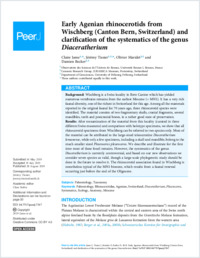Early Agenian rhinocerotids from Wischberg (Canton Bern, Switzerland) and clarification of the systematics of the genus Diaceratherium
- Jame, Claire Observatoire des Sciences de l’Univers de Rennes, Université Rennes I, France
- Tissier, Jérémy Cenozoic Research Group, JURASSICA Museum, Porrentruy, Switzerland - Department of Geosciences, University of Fribourg, Switzerland
- Maridet, Olivier Cenozoic Research Group, JURASSICA Museum, Porrentruy, Switzerland - Department of Geosciences, University of Fribourg, Switzerland
- Becker, Damien Cenozoic Research Group, JURASSICA Museum, Porrentruy, Switzerland - Department of Geosciences, University of Fribourg, Switzerland
-
28.08.2019
Published in:
- PeerJ. - 2019, vol. 7, p. e7517
English
Background: Wischberg is a Swiss locality in Bern Canton which has yielded numerous vertebrates remains from the earliest Miocene (= MN1). It has a very rich faunal diversity, one of the richest in Switzerland for this age. Among all the mammals reported in the original faunal list 70 years ago, three rhinocerotid species were identified. The material consists of two fragmentary skulls, cranial fragments, several mandibles, teeth and postcranial bones, in a rather good state of preservation.Results: After reexamination of the material from this locality (curated in three different Swiss museums) and comparison with holotype specimens, we show that all rhinocerotid specimens from Wischberg can be referred to two species only. Most of the material can be attributed to the large-sized teleoceratine Diaceratherium lemanense, while only a few specimens, including a skull and mandible, belong to the much smaller sized Pleuroceros pleuroceros. We describe and illustrate for the first time most of these fossil remains. However, the systematics of the genus Diaceratherium is currently controversial, and based on our new observations we consider seven species as valid, though a large-scale phylogenetic study should be done in the future to resolve it. The rhinocerotid association found in Wischberg is nonetheless typical of the MN1 biozone, which results from a faunal renewal occurring just before the end of the Oligocene.
- Faculty
- Faculté des sciences et de médecine
- Department
- Département de Géosciences
- Language
-
- English
- Classification
- Palaeontology
- License
-
License undefined
- Identifiers
-
- RERO DOC 327412
- DOI 10.7717/peerj.7517
- Persistent URL
- https://folia.unifr.ch/unifr/documents/308114
Statistics
Document views: 132
File downloads:
- pdf: 179
